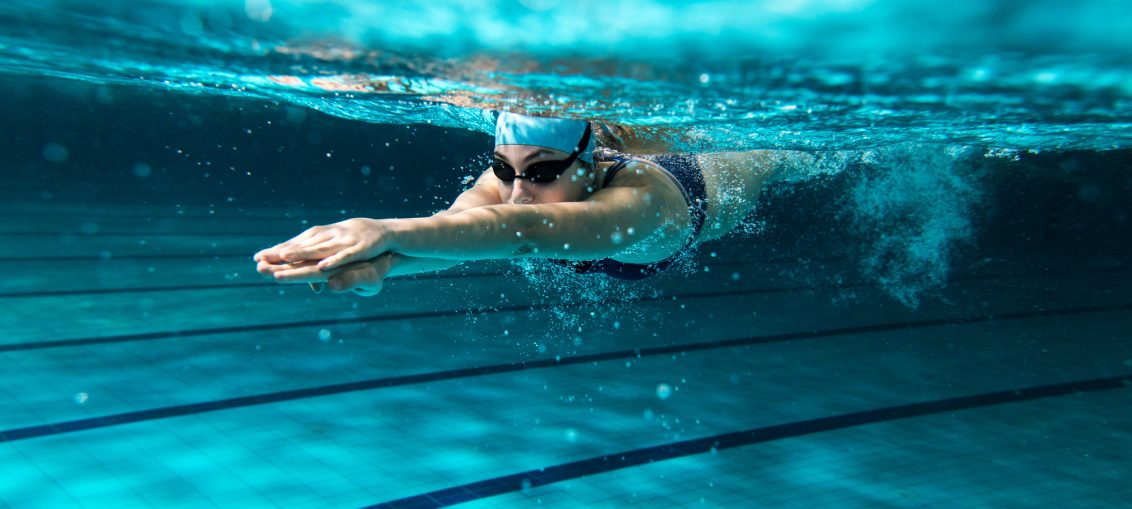
When you’re doing a triathlon, you’re putting your body through a lot. There’s not much you can do to vary running motions or biking motions.
However, there are at least five ways you can change your swimming motions. Giving your already tired muscles a break will conserve your energy for when you’re out of the water.
How do you do that? Learn different swimming strokes. Yes, maybe some you’re slower at than others, but it’s better than having to slow down for a cramp later on.
If you work different strokes into your practice, even one day a week, you can work in a five-minute swim break.
Most triathlon swimmers don’t vary their types of swimming strokes, which tires out the same muscles over and over. Don’t be like them! Get our guide to mixing up strokes below.
Types of Swimming Strokes
The freestyle stroke is the first one most swimmers learn. It’s the classic, left, right, left, breathe stroke.
It’s a great stroke for speed and efficiency.
1. The Freestyle: Full Body
Keeping your body in a straight line and using your arms in conjunction with your legs is a full body workout. You also need to keep your brain in the game, by timing your breaths.
There are plenty of accessories you can use with your freestyle strokes for practice. They make hand paddles that build your strength and put more power behind your strokes.
You can use small, leg-shaped floats that hold your thighs together so all your kick strength comes from your calves. This also keeps your alignment on point while you practice.
Perfect practice makes perfect, as they say. The resistance from the water works your core, your arms, neck, shoulders, chest, upper back, and your legs!
Pretty much everything, except maybe your glutes. If you want some strong back muscles (important for keeping good form while running) this is a great stroke.
If you’re training for a triathlon for fun and don’t want to be a professional, you may not want a swimmer-sized back. Their wide shoulders and broad back look swimmers get come from this stroke.
That’s another benefit to mixing up your strokes, you won’t over-tone one part of your body!
2. Breaststroke: Legs and Back
The breaststroke is surprisingly hard to master. It has a very specific rhythm and the littlest change can throw your whole lap off.
However, it’s a good stroke to do if your arms are tired. Most of the power from the breaststroke comes from your big kick and the rowing motion of your back muscles.
If you have back or shoulder pain (normal in bikers from hunching over) this is a more natural pose for your torso.
The alignment helps keep your spine neutral and gives it a break from the constant impact of running.
Runners have a lot of injuries, including their knees. The breaststroke strengthens all muscles in the leg, without the damage of impact. This is a great way to counter-act your running training and help prevent injuries.
Strengthening your hamstrings and calves build a muscle protection of sorts around your knee tissue. The stronger the muscle, the more protected your knee is. We’re not saying injury is impossible, but an ounce of prevention always helps!
3. Butterfly Stroke
The butterfly is a huge energy drain, so we don’t recommend using it on race day. However, there’s no reason you shouldn’t practice it. It’s an amazing workout.
It engages your core, which you need to keep tight for proper running and biking form. A tight core is essential for avoiding injuries in even day to day activities.
This stroke works your back muscles and can help you keep better posture. It increases your flexibility since you have to extend your torso during the stroke’s movements.
It burns the most calories of any stroke on our list, so bring it in when you need a low-impact but heavy cardio day.
4. Side Stroke
The sidestroke is a go to if you’re in the water and feeling tired. It’s much more relaxing than any of the other strokes and gives you a break.
If you get a cramp on one side, flip and do the side stroke on the other. Your cramp side gets a break but you don’t stop moving, which breaks your rhythm and makes cramps worse.
It’s slow, so don’t do it for too long, but take a mini-break when you need to!
5. The Backstroke
Yes, this childhood classic helps you tone your whole body. Namely, the back of your body! Bikers and runners can benefit from its hip-work and glute strengthening.
It gives your spine time to decompress and lengthen, especially after running for a long period of time. It’s not particularly fast or powerful, but it may feel really good after a long day of training.
Use it like the side stroke, as a mini-break and an in-water stretch.
Your Best Type of Stroke
Your body is different than anyone else’s. You’ll find that you’re fastest at one stroke or that one feels best on your body.
If it’s not one of the slow ones, prioritize that stroke. It’s more important that you can swim for long periods comfortably than to obsess about doing the same stroke as everyone else.
If you win the race and you did the whole swim with breaststroke, they won’t take your medal away.
In fact, people will probably try your method. Don’t be afraid to try different types of swimming strokes.
It could lead to the perfect win! Want other tips that make you a better triathlete? Check out our blog, we post new content all the time!
